
A Royal in the Sky: Getting Acquainted with the Celestial King in Cepheus Constellation
Study Guide
Cepheus Constellation aka The King
Where and When To See the Cepheus Constellation
Seeing Cepheus Through Cassiopeia
Cepheus and His Stars
A Planet in the King’s Constellation
Deep-sky Objects in Cepheus Constellation
Star Clusters
Galaxy
Nebulae
Mythology Related to Cepheus Constellation
Cepheus Constellation aka The King
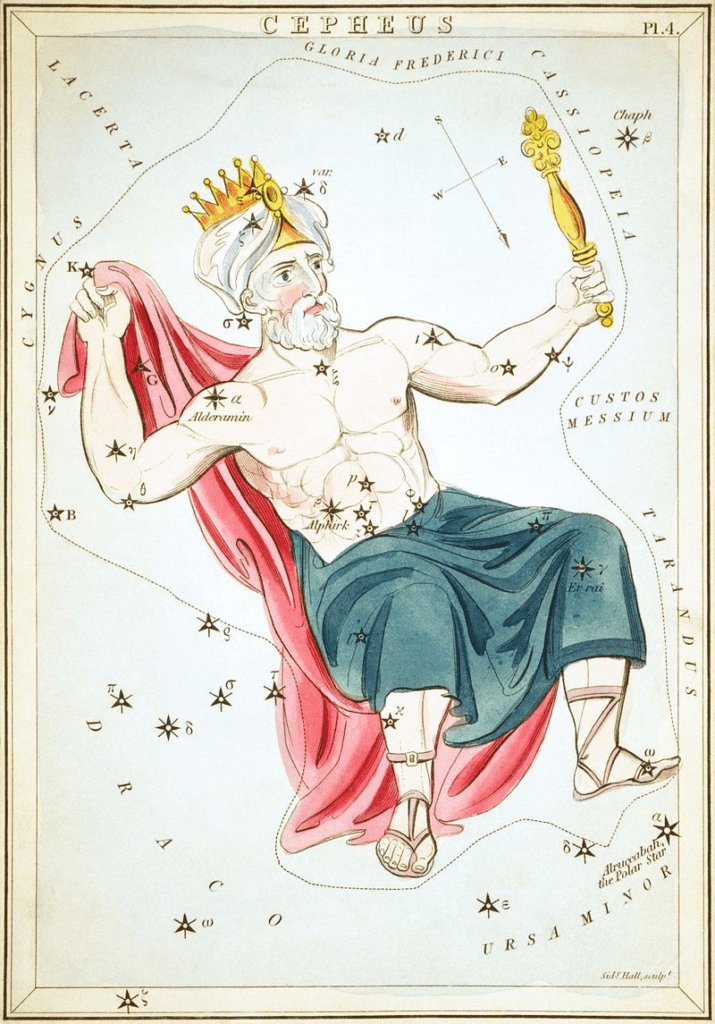
The constellation of Cepheus the king is among the 48 constellations included in the Almagest by Ptolemy in the second century. Today, it is included in the 88 modern constellations recognized by the International Astronomical Union (IAU). It belongs in the Perseus family of constellations together with Perseus itself, Andromeda, Lacerta, Auriga, Cassiopeia, Cetus, Pegasus, and Triangulum.
The name of this constellation is based on King Cepheus of Aethiopia (also Ethiopia) in Greek Mythology. It is often abbreviated as “Cep.” The celestial king is depicted holding a scepter. His arms are often in the air as if praying to the gods to spare his daughter, relating to its mythology.
It is a relatively big constellation, with an area of 588 square degrees. It is the 27th largest constellation in our night sky. Cepheus the king looks like the simple house drawing we had as little kids!
Some sources have the house-like version but with some extra lines.
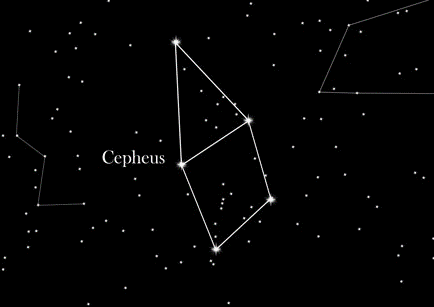
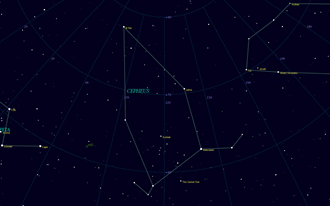
Where and When To See the Cepheus Constellation
The Cepheus constellation is circumpolar in the Northern Sky. Even if we can see it all year round, we can see it best at 9 pm in the month of November. It lies between latitudes +90° and -10° in the fourth quadrant of the northern hemisphere (NQ4). Though it has great size, most of its stars are not that bright so identifying it in the sea of stars can be a challenge to some. Thankfully, we can locate it through its neighboring constellations.
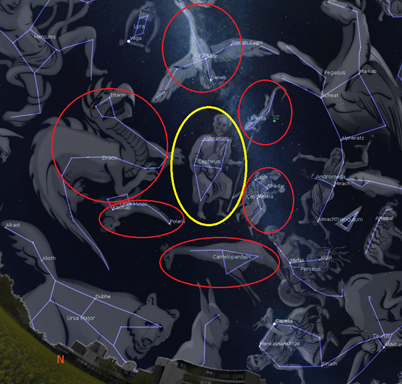
Cepheus is bordered by the constellations of Cygnus the Swan, Draco the Dragon, Ursa Minor the Little Bear, Camelopardalis the Giraffe, Cassiopeia the Seated Queen, and Lacerta the Lizard.
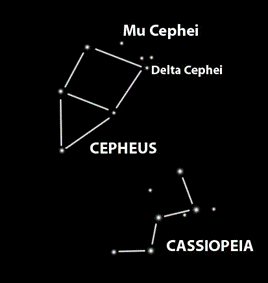
Seeing Cepheus Through Cassiopeia
Another way we can see it is by specifically looking for Cassiopeia, the queen. The distinct W shape of Cassiopeia is easy to identify because it is made up of bright stars that are visible to the naked eye. If we see the opening of this W in Cassiopeia, we can then locate the celestial king!
Cepheus and His Stars
Cepheus the King has many stars, seven of which are its main stars. Four of them are formally named by the International Astronomical Union (IAU).
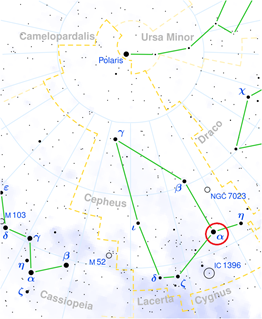
Alderamin (α Cephei)
Alderamin is known as Alpha Cephei in the Bayer designation. It is called 5 Cephei in the Flamsteed designation. This is an A-type star. Though it is a white main-sequence star, it is becoming a subgiant. Alpha Cephei is the brightest star in the constellation of Cepheus the King. We can see it to the naked eye because it has an apparent magnitude of about 2.5. It is a slightly variable star so its brightness changes a little to about 0.06. The distance of this star is estimated to be 49 light-years from us.
The traditional name of Alpha Cephei, Alderamin, is Arabic in origin. It is from the phrase al-dhirā‘ al-yamīn, which means “the right arm”. It is a fast rotating star, having a speed of about 246 km/s. Because of this, it completes its revolution in just 12 hours or less.
Alderamin lies near the precessional path of our planet’s North Pole. Precession is the change in orientation of the Earth’s axis. This means that the Earth’s North Pole will not be pointing to the same North star of today forever. Polaris will not be the North star anymore. Since it is 3° off the precessional path, Alderamin will become the North Star in about 7500 AD.
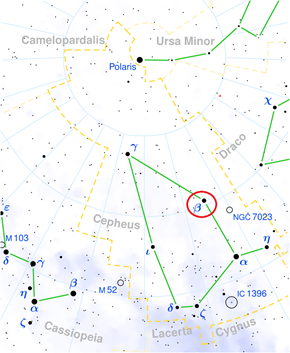
Beta Cephei (β Cephei)
Beta Cephei is a triple star system that is about 690 light-years away from the Sun. It is a variable star with an apparent magnitude between 3.16 – 3.27. Its regular pulsation is every 4 hours 34 minutes. This star is the prototype of the Beta Cephei variables.
The Beta Cephei variable stars are also called Beta Canis Majoris stars. The brightness of these stars changes because of the pulsations in their surfaces. These pulsations are driven by iron in their interiors.
Below are the stars that make up the triple star system of Beta Cephei:
- Beta Cephei A
Beta Cephei A is a binary. It is composed of Beta Cephei Aa and Beta Cephei Ab.
- —Beta Cephei Aa
Beta Cephei Aa is the primary star in the Beta Cephei system. Its traditional name is Alfirk. The name is from the Arabic term al-firqah which, in English, means “the flock” referring to sheep. The stellar classification of this blue subgiant star is B1 IV. It is said to be only a few million years old, so we can say that it is a young star. The mass of Alfirk is 12 times more than that of our Sun’s.
- —Beta Cephei Ab
Beta Cephei Ab is a Be star. A Be star is a B-type star with hydrogen emission lines in the spectrum.
- Beta Cephei B
Beta Cephei B is a main-sequence star with a stellar classification of A2. It has an apparent magnitude of 7.8.
The International Astronomical Union (IAU) formed a group in 2016 to assign names for each star instead of the entire system. Though the multiple star system of Beta Cephei was traditionally known as Alfirk, the name now specifically and formally refers to the primary component, Beta Cephei Aa, in the List of IAU-approved Star Names.
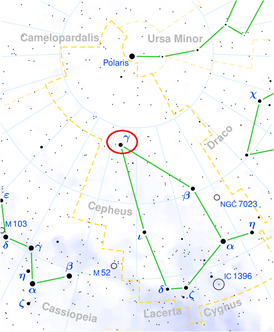
Gamma Cephei (γ Cephei)
Gamma Cephei is a binary star system with an apparent magnitude of roughly 3.22, though it is suspected to be a variable star. It is about 45 light-years away from us. The components of this system are Gamma Cephei A and Gamma Cephei B. Gamma Cephei lies near the precessional path of the Earth in the north celestial pole, so it is most likely the next North Star after Polaris. But that is nothing we should worry about since that will happen around 3,000 AD.
- Gamma Cephei A
Gamma Cephei A is an orange star of K1 stellar classification. It is the primary component of the Gamma Cephei star system and accounts for most of its apparent magnitude. The formal name of this star is Errai. It is Arabic in origin, ar-rā‘ī, which means “the shepherd.” Errai was the traditional name of the Gamma Cephei system but now refers to the individual star as decided by the Working Group on Star Names (WGSN).
Errai is a relatively old star estimated to be about 3.25 billion years old already. An exoplanet is found to be orbiting Gamma Cephei A. It is called Gamma Cephei Ab.
- Gamma Cephei B
Gamma Cephei B is an M-type star that is much fainter than its primary.
The mass of this red dwarf star is about 0.409 times the Sun’s.
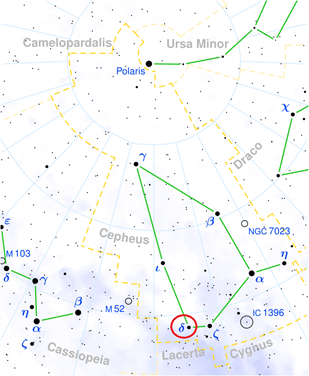
Delta Cephei (δ Cephei)
Delta Cephei is a variable star with an apparent magnitude ranging from 3.48 to 4.37. The diameter of this star is about 40 to 46 times the diameter of our Sun. It is a double star. The brighter component is an F-class supergiant while the companion is said to be a bluish B-class star. It is estimated to be 891 light-years away.
Delta Cephei serves as the prototype of the Cepheid class of variable stars or Cepheids for short. A Cepheid variable pulsates, and when it does, its diameter and magnitude changes. These pulsations are caused by ionized helium. When Delta Cephei pulsates, its stellar class also changes from F-type to G-type. Its period of pulsation takes about 5 days.
Epsilon Cephei (ε Cephei)
Epsilon Cephei is a variable star with an apparent magnitude of 4.15 to 4.21. It has a yellow-white hue and is believed to be a main sequence or a subgiant F-type star. It is 85 light-years from our Sun.
A companion star was detected in Epsilon Cephei. This faint star is likely a K-type or an M-type star.
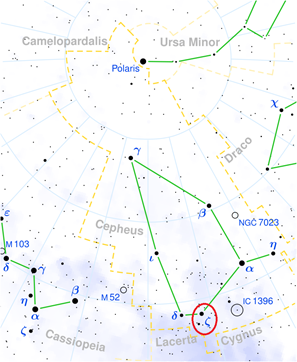
Zeta Cephei (ζ Cephei)
Zeta Cephei is a K-type supergiant star. It is more massive than our Sun by about 8 times and is 3,600 more luminous than it. This orange star has an apparent magnitude of 3.4, so it is visible to the naked eye. It is about 840 light-years away from us according to the Hipparcos data of 2007. It is suspected that the star has a companion but nothing is confirmed yet.
In the constellation of Cepheus, Zeta Cephei is the star that marks the King’s left shoulder.
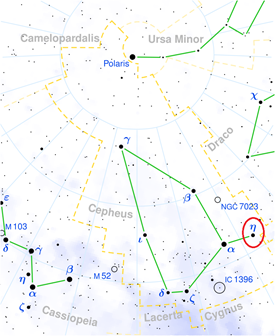
Eta Cephei (η Cephei)
Eta Cephei is one of the stars in the night sky that we can see with our naked eye. It has a visual magnitude of 3.4 and is said to be about 47 light-years away from us. This K-type star is evolving to become a giant star. It is about 2.5 billion years old already and 1.6 times greater than our Sun’s mass. Experts have seen the possibility of a companion star but it is not yet confirmed.
The traditional name for Eta Cephei is Al Kidr, which it shares with Theta Cephei. The three stars Alpha Cephei ( traditionally called Alderamin), Beta Cephei (traditionally known as Alfirk), and Eta Cephei were called Al Kawākib al Firḳ or “the Stars of The Flock” by the astronomer Ulug Beg.
Theta Cephei (θ Cephei)
Theta Cephei is another binary star system in the Cepheus constellation. It is in the A7 stellar class so it has a notable blue-white hue. Its apparent magnitude is about 4.2, so we can see it without using any viewing instruments. The distance of this star to our planet is roughly 127 light-years. It shares the name Al Kidr with Eta Cephei.
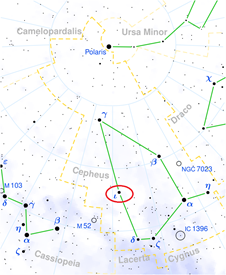
Iota Cephei (ι Cephei)
Iota Cephei is a giant star of K0 III stellar classification. This is one of those stars that makes up the outline of the northern constellation of Cepheus. We can see it with the naked eye because it has an apparent magnitude of 3.5. The distance of Iota Cephei is about 115 light-years away from us. It has a mass that is 2.15 times that of our Sun and more luminous than it by 57 times.
Iota Cephei lies within 5° of the Earth’s precessional path together with Alfirk, another star in the celestial king’s constellation. The two stars are likely to be the Pole Stars of the North in about 3,000 years.
Kappa Cephei (κ Cephei)
Kappa Cephei is a B-type binary star system. It is not part of the stars that make up the outline of Cepheus the King but is within the constellation’s boundaries. It has an apparent visual magnitude of 4.4 so we can see it using the naked eye, though it is rather faint. According to the Hipparcos data of 2007, it is 314.83 light-years distant from us. The two stars of the system are Kappa Cephei A and Kappa Cephei B. They are gravitationally bound to each other.
- Kappa Cephei A
Kappa Cephei A is the primary star in the binary system of Kappa Cephei. It is a blue giant in the B9III stellar classification.
- Kappa Cephei B
Kappa Cephei B is a main-sequence star having a stellar classification of A7V. It is an 8th magnitude star so we cannot see it with the naked eye.
Lambda Cephei (λ Cephei)
Lambda Cephei is an O-type star. It is one of the hottest stars in the sky with a temperature of 25,000 degrees Kelvin or more. The apparent visual magnitude of this blue supergiant is 5.05 so it can be seen by the naked eye. It is about 1,977 light-years away from our planet.
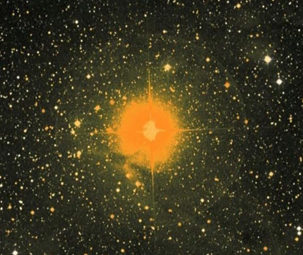
Mu Cephei (μ Cephei)
Mu Cephei is also called Herschel’s Garnet Star because it was William Herschel who noted its striking deep garnet colour. It is a variable star with an apparent magnitude between 3.4 and 5.1. This M-type red supergiant is very luminous and is one of the largest stars ever observed. In fact, it is about 100,000 more luminous than our Sun, and Mu Cephei’s radius is more or less 1,000 times greater than it! Other names for this star are Garnet sidus, Erakis, and HD 206936. It is estimated to be about 2,400 light-years away from us.
Mu Cephei is fusing helium into carbon, which is an indication that it is already in the final stage of its life as a star. A star as big as Mu Cephei will likely produce a great explosion evident to a supernova.
Nu Cephei (ν Cephei)
Nu Cephei is a fourth magnitude A-type star in the Cepheus constellation. This pulsating supergiant belongs in the Alpha Cygni variables. It has an apparent visual magnitude of 4.289 which changes during its variable period between 4.25 – 4.35. The size of an Alpha Cygni variable star changes because of its pulsations. This change is caused by the contraction and expansion of the star’s surface happening at the same time. Recent data shows that Nu Cephei is 190 times the size of the sun and 15 times as massive.
Xi Cephei (ξ Cephei)
Xi Cephei is an Am star. An Am star is an A-type star that has strong absorption of some metals while having deficiencies or underabundance of other metals. Because of its chemical peculiarity and unique absorption lines, it is also called a metallic-line star. Xi Cephei is a multiple star system with a combined apparent visual magnitude of about 4.2. It is located about 86 light-years from our planet. The traditional name of Xi Cephei is Kurhah, but officially the name is now specifically designated to the primary star component.
The components are called Xi Cephei A, B and C. Both Xi Cephei A and B are spectroscopic binary star systems. The components of Xi Cephei A are Aa or Kurhah, the primary component, and Ab.
Omicron Cephei (ο Cephei)
Omicron Cephei is another star that belongs in the Cepheus constellation. Though it does not outline the form of the celestial king, it is within the boundary of the constellation. It is a binary star system with an apparent magnitude of 4.75.
Pi Cephei (π Cephei)
Pi Cephei is a multiple star system. It appears yellow because it is a G-type star, just like our Sun. It has an apparent magnitude of 4.4 so we can see it with the naked eye. The primary star of this multiple is system is a spectroscopic binary.
Rho Cephei (ρ Cephei)
Rho Cephei is the name of two different stars in the Cepheus constellation. Because they share the same Bayer designation, they are numbered 1 and 2 to avoid confusion. The two forms an optical pair.
- Rho1 Cephei (ρ1 Cephei)
Rho1 Cephei is a double star with an apparent magnitude of about 5.84. It is 206 light-years away from us. The primary star of this pair is an A-type star of A2m stellar classification.
- Rho2 Cephei (ρ2 Cephei)
Rho2 Cephei is a main-sequence star with A3 V stellar classification. The distance of this solitary star to our Sun is about 245 light-years. It has an apparent magnitude of 5.50, making it visible to the unaided eye.
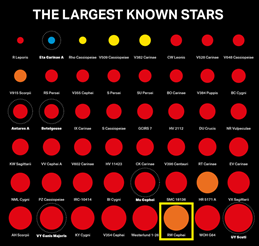
RW Cephei
RW Cephei is a very large star. In fact, it is one of the largest stars ever known! Some sources call this star an extreme supergiant while others call it a hypergiant. Since it is a variable star, its apparent magnitude or brightness as we see here on Earth changes between 6.0 to 7.3.
VV Cephei
VV Cephei is an interesting star system because its primary component is one of the largest stars discovered in our galaxy. The system has a distance of roughly 4,900 light-years from our planet. Its apparent magnitude is about 4.91. This eclipsing binary is made up of VV Cephei A and VV Cephei B. The pair has a long orbit period of about 20.3 years. It is considered the second-longest period among eclipsing binary stars after Epsilon Aurigae, which takes 27.1 years.
During the period, primary and secondary eclipses happen when VV Cephei A eclipses VV Cephei B and vice versa. Accurate data of the mass and temperature of these two stars are hard to determine because of the eclipses and their long orbit period.
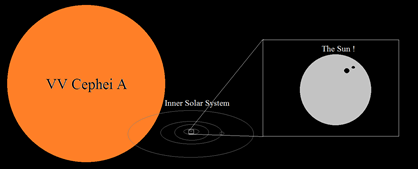
-
VV Cephei A
VV Cephei A is an M-type cool red supergiant. Its radius is said to be about 1,050 and 1,900 times the radius of our Sun, making it one of the largest known stars. It is also more luminous than our Sun by about 200,000 times!
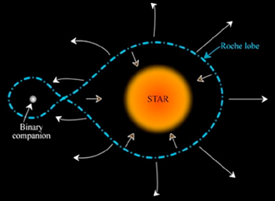
During the primary eclipse, VV Cephei A completely blocks VV Cephei B. This happens when the primary fills its Roche lobe. The Roche lobe is an area surrounding a star in a binary system. In that area, the material is bound to the star gravitationally. When VV Cephei A is closest to VV Cephei B, the material is transferred from the primary to the secondary star. This is the cause of the primary eclipse because the transferred material creates a large disk concealing VV Cephei B.
-
VV Cephei B
VV Cephei B is the secondary component in the VV Cephei system. It is a relatively smaller star than the primary but it is a hot one. It is a B-type main-sequence star. During the secondary eclipse, VV Cephei B only obscures a small part of the primary star.
T Cephei
T Cephei is already in the late stage of its life. It is a red giant classified as a Mira variable star. Mira variables are late-stage pulsating stars. The apparent magnitude of
T Cephei changes between 5.2 to 11.3. It is more luminous than the Sun by about 5,700 times.
W Cephei
W Cephei is a variable binary system with a brightness between 7th to 9th magnitude. The components are W Cephei A and B. W Cephei A is the primary in the pair and is a red supergiant star. It is a very big and luminous star. The system is located about 8,000 light-years away from us.
V354 Cephei
V354 Cephei is one of the largest stars ever known. It is a cool red supergiant that is about 9,000 light-years away. It is an irregular variable, which means the change in its brightness has no specific period. The radius of this star is estimated to be between 689 to 1,520 times the radius of the Sun.
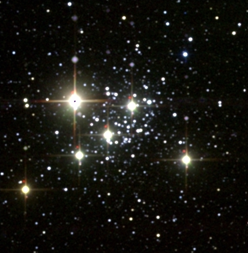
MY Cephei (IRC +60375)
MY Cephei is an M-type supergiant. Since it is a semiregular variable, its apparent magnitude changes between 14.4 and 15.5. It is a very large star and that is also very luminous. The brightest star in the picture above is MY Cephei.
Kruger 60
Kruger 60 is also called DO Cephei. We cannot see it with the naked eye because it has an apparent magnitude of 9.59. This star is named after the German astronomer Adalbert Kruger.
The binary star system is about 13.15 light-years away from the Sun. The orbit period of the two is 44.6 years. Astronomers have proposed Kruger 60 as the origin of the comet 2I/Borisov. The two red dwarf stars in the system are labeled Kruger 60 A and Kruger 60 B.
- Kruger 60 A
The Kruger 60 A star is estimated to have a mass of 27% that of the Sun and 35% its radius.
- Kruger 60 B
Kruger 60 B is a flare star. The brightness of a flare star greatly increases in just a short period of time, and then goes back to its state after some time.
A Planet in the King’s Constellation
There is only one exoplanet in the Cepheus constellation. It is called Gamma Cephei Ab because it orbits around the star Gamma Cephei A, also known as Errai.
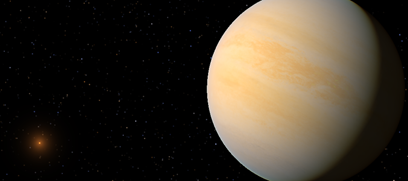
Gamma Cephei Ab (Tadmor )
Gamma Cephei Ab is an extrasolar planet having a minimum of about 1.59 times the mass of Jupiter. It is officially named Tadmor by the International Astronomical Union (IAU). Tadmor follows an elliptical orbit and completes it in about 2.5 years. Technically, it could have been the first true exoplanet discovered since it was already detected as early as 1988. It was only confirmed in 2002.
Deep-sky Objects in Cepheus Constellation
There are no Messier Objects and Meteor Showers associated with the constellation of Cepheus the celestial king. But interestingly, there is a great number of fascinating celestial objects within it. The quasar S5 0014+81 is just an example. Let us explore them!
Star Clusters
Star clusters are groups of stars. If the cluster is made up of gravitationally bound old stars, they are called globular clusters. If the group contains lesser and younger stars that are looser, it is an open cluster. There are many open clusters in the constellation of Cepheus.
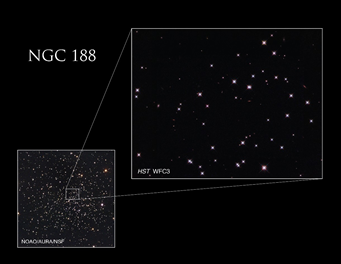
NGC 188 (Caldwell 1)
NGC 188 is the first celestial object in the Caldwell catalog. It has an apparent magnitude of about 8.1. This open cluster is made up of stars of about the same age. What is unique about it is that these stars do not drift apart like in other open clusters. It is said to be about 6.8 billion years old already.
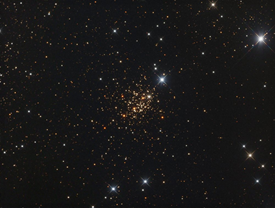
NGC 7419
NGC 7419 is an open cluster. It is home to five red supergiants in the Cepheus constellation. These large stars are RW Cephei, MY Cephei, Mu Cephei, VV Cephei, and V354 Cephei. Among these five, the brightest is MY Cephei. NGC 7419 has numerous Be stars. The open cluster is more or less 14million years old.
Galaxy
A galaxy is a system of interstellar matter and stars that are bound by gravity. Our Solar System belongs in the Milky Way galaxy. A galaxy is also found in the Cepheus constellation.
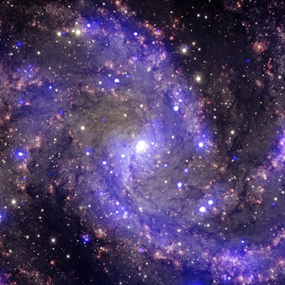
NGC 6946 (Fireworks Galaxy)
NGC 6946 is an intermediate spiral galaxy which is also called the Fireworks Galaxy. It is located between the Cepheus and Cygnus constellations. It was discovered by William Herschel in 1798. Another name for this deep sky object is Caldwell 12. It is located 25.2 million light-years away from Earth. The Fireworks Galaxy only has about half the total number of stars in the Milky Way but it has way more supernovae. It is because of this high number of supernovae that it is popularly called the “Fireworks Galaxy.”
Nebulae
According to NASA, a nebula is a giant cloud of dust and gas in space. There are many nebulae in the constellation of the celestial king.
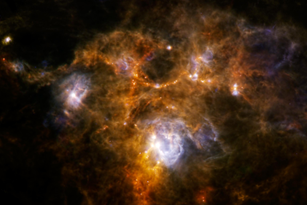
NGC 7538
NGC 7538 is a nebula about 9,100 light-years away from us. The stars in this nebula are not yet in the main sequence. They are called pre-main-sequence stars (PMS stars). PMS stars contract and eventually become main sequence stars. Before all of that, a star starts as a protostar, the earliest phase in the life of a star. At that time, it still gathers mass from the surrounding cloud. The largest protostar ever discovered is in NGC 7538. This baby star is really big as it is the size of our Solar System but only 300 times more!
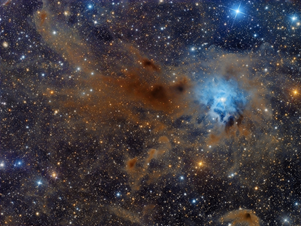
NGC 7023 (Iris Nebula)
The Iris Nebula is a reflection nebula with an apparent magnitude of about 6.8. It is about 1,300 light-years away. NGC 7023 is actually the name of a star cluster in this nebula. The two names are used interchangeably and mean the Iris Nebula and the NGC 7023 star cluster all the same. The nebula has a blue color because of its central star, SAO 19158.
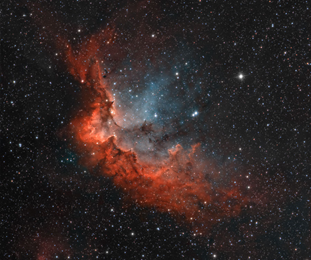
NGC 7380 (Wizard Nebula)
NGC 7380 is an open cluster made up of young stars. In 1787, it was discovered by Caroline Herschel and then her brother William Herschel added it in his catalog. It is surrounded by an emission nebula called the Wizard Nebula. This region is 7,200 light-years away from us, having an apparent magnitude of 7.2. The nebula got its name because it looks like a medieval sorcerer! This shape was created because of the stellar winds and radiation from the young stars in NGC 7380.
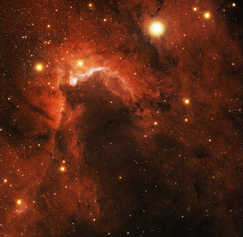
Sh2-155 (Cave Nebula)
Sh2-155 is a diffuse nebula commonly known as the Cave Nebula. It is also called Caldwell 9. This region is about 2,400 light-years away from us. It is said that the star formation activity in Sh2-155 is because of the radiation of HD 217086, a hot O star in the Cepheus constellation.
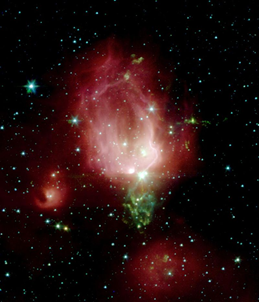
NGC 7129
NGC 7129 has a distinct rosebud shape. It lies in a dusty region of the celestial king’s constellation. This reflection nebula got its color from an open cluster made up of young stars. Many of these stars are below one million years of age. The part of NGC 7129 that looks like a stem of the rosebud is produced because of jets of supersonic gas from young stars in the heart of the nebula.
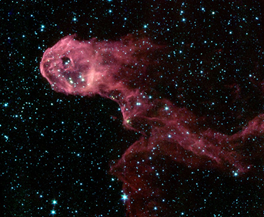
IC 1396 (Elephant’s Trunk Nebula)
IC 1396 is a large emission nebula in the Cepheus constellation. The Elephant’s Trunk Nebula, designated IC 1396A, is just a part of it. It is located 2,400 light-years away from us. The region is ionized by a massive star called HD 206267. This ionization and the stellar wind from the young stars make the Elephant’s Trunk Nebula a site for star formation.
Mythology Related to Cepheus Constellation
The mythology of the celestial king not only involves his story but his entire family’s. They were the royal family in the land of Ethiopia. Ethiopia in the story refers to the stretch of land in the Mediterranean, not the country that we know today. Here is the story:
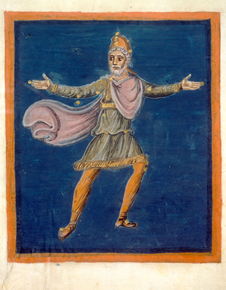
King Cepheus was the king of Ethiopia alongside his queen, Cassiopeia. He is the father of Andromeda. Cassiopeia was a beautiful woman but she was also very vain. She claimed that she is more beautiful than the Nereids (sea nymphs). One of the sea nymphs is Amphitrite, the wife of the sea god Poseidon. The Nereids and Poseidon were angry when they heard about what Cassiopeia said.
Poseidon brought damage to Ethiopia and said that he will only stop if King Cepheus will sacrifice his daughter Andromeda to Cetus, the sea monster. The king and the queen obliged and left their daughter chained to a rock near the sea. Just as the sea monster is about to attack her, the hero Perseus arrived. He has just returned from slaying the Gorgon Medusa. He rescued the princess and killed Cetus.
Perseus later married Andromeda. But during the celebration, Phineus arrived. Phineus is the brother of the king, Cepheus. He said that he should be the one marrying Andromeda. Cepheus the King objected and a fight happened. When Perseus’ side was about to lose, he used the head of Medusa to turn Phineus and his men to stone. Unfortunately, Cepheus and Cassiopeia were not able to look away in time and they, too, turned into stone.
When Zeus heard about the death of Cepheus, he put him in the sky because he is related to Io who is one of his lovers.